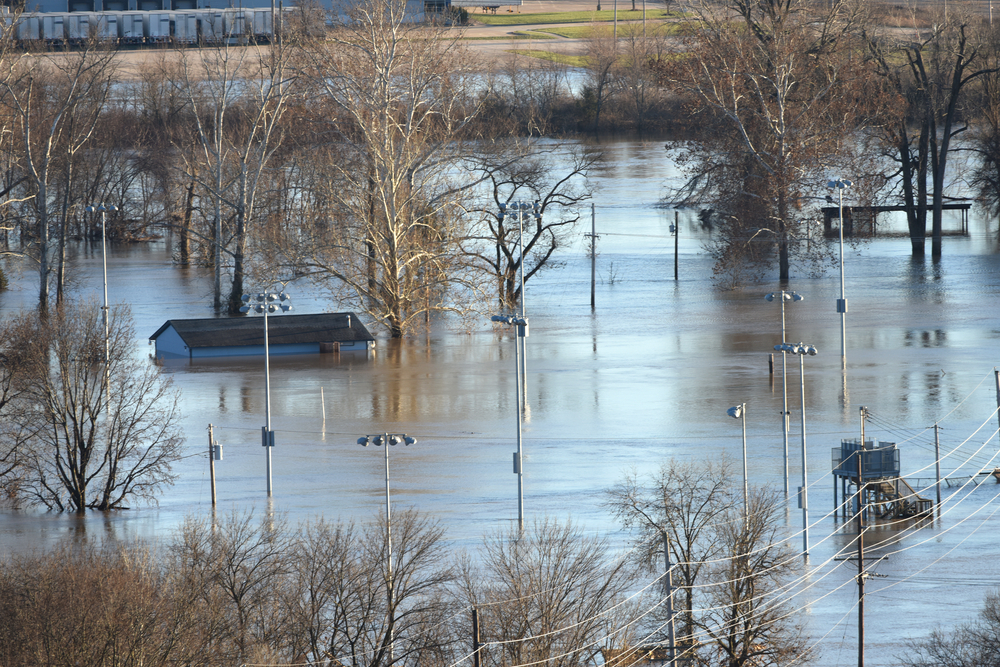US farmers count cost of catastrophic ‘bomb cyclone’ in midwest
With grain stores ruined and many fields still under water from last month’s extreme weather, producers are facing devastating losses
Five weeks after historic flooding in the midwest, waters still cover pasturelands, corn and soybean fields. Much of the water has receded, but rivers still run high and washed out roads force people to take long detours. Residents in Missouri are putting their ruined possessions on the street and corn stalks heaped by floodwaters look like snowdrifts in the fields.
In March, more than 450,000 hectares (1.1m acres) of cropland and 34,000 hectares of pastureland flooded, according to an analysis of government and satellite data, prompting governors from Nebraska, Iowa, Missouri, Wisconsin and Minnesota to declare states of emergency.
In all, the damage could cost the country more than $3bn (£2.3bn). Farmers and ranchers are still tallying the number of bushels and heads of cattle lost. And though the damage is unlikely to immediately affect the national or international price of grain and meat, the farmers who experienced the loss will feel the pinch.
“We’re talking about an event here of historic proportions, circumstances that nobody ever recalls ever happening in their lifetime,” said Steve Wellman, the Nebraska Department of Agriculture director and third-generation farmer.
The “bomb cyclone” – an intense winter storm – that swept through the US in March followed record-breaking cold in January and unprecedented snow in February. Huge blocks of loose ice jammed waterways, and the Missouri river swelled, topping levees in four states, and breaking dams.
Climate change, experts say, is altering the landscape for the American farmer. Climate models predict more extreme weather patterns in the midwest over the coming decades that may further damage small-scale commodity and meat producers, making it more difficult for them to make a profit as hurdles mount.
The threat of more flooding still looms over the region. The National Oceanic and Atmospheric Administration predicts that snowmelt could inundate rivers as the spring wears on.
As these events happen more frequently, “it will be tougher for producers to stay in business long-term”, said Scott Brown, an associate extension professor at the College of Agriculture, Food and Natural Resources and the University of Missouri-Columbia. Federal farm assistance programmes, he said, probably won’t save the hardest hit.
The extreme weather, which occurred during calving season, whisked newborns into freezing waters, and ice jams broke the legs of cattle. Floodwaters seeped into bins where farmers stored grain ready for sale, the soybeans inside expanding until the containers exploded in slow motion.
“That will all have to be destroyed because it’s contaminated,” said Blake Hurst, a farmer and president of the Missouri Farm Bureau of the wet grain. “It’s a mess.”
Though uncounted bushels of grain were ruined, a large surplus of the crop still sits on higher ground or in bins elsewhere. In the last few years, farmers and ranchers in the midwest have had record yields. Crop production in Nebraska alone, the third largest corn-producing state in the country behind Iowa and Illinois, reached $8.8bn last year.
Adam Meyerkorth owns a crop dusting business and helps on his dad’s 800-hectare corn and soybean farm in north-west Missouri’s Atchison county. He said he could be feeling the flood’s effects all year. More than 95% of the farm is still submerged and is likely to stay that way until the US Army Corps can repair the levee along the Missouri river.
For now, Meyerkorth and his family of five are staying at the municipal airport. “The general public, when they hear ‘flood’, they hear, ‘Water up, water down – you go in, you fix it, and get back to life.’ Well, we could be displaced for nine months or more,” he said. “This one happened 16 March and we could be looking at September or October before we can physically drive back in, turn power on, and start cleaning everything back up.”
Though consumers are unlikely to feel the immediate impact, the floods came fast on hard times for American farmers. In 2018, bankruptcies of midwestern farms were up 19% from the year before, the American Farm Bureau reported. Incomes have fallen by more than half over the last five years thanks to the high quantities of grain on the market. Tariffs from China, Mexico and Canada on American meat and dairy products, in response to President Trump’s tariffs, have also made trade sluggish. Many farmers hoping for higher prices stockpiled grain on their land.
Destroyed roads and bridges make getting grain to feed cattle more costly. Some farmers may not be able to plant their crop this year because the land is either too wet or still underwater.
“You can draw a scenario where a substantial number of farmers will go out of business if all the breaks go the wrong way,” said Hurst. “It’s too early to tell how many people will lose their farms.”
For those farmers and ranchers who felt the brunt of the flooding, government programmes exist to help manage their losses. If a farmer can’t plant this year, crop insurance can pay up to 60% of what a farmer would have made. States and towns will have to fix broken levees, however, before a farmer can purchase insurance for next year’s crop. And no programme exists for stored grain lost in a flood.
For ranchers, the Department of Agriculture’s Livestock Indemnity Program pays ranchers for cattle lost in a natural disaster. It will take up to a year, though, for ranchers to see how this event changed their herd sizes or profits because calves won’t go to market for another year, and illness could still affect the herd.
“It’s the local issues that are the most important when we think about what’s happened from a flooding standpoint,” said Brown. “For those directly affected, what’s already a tough situation becomes a lot harder.”

